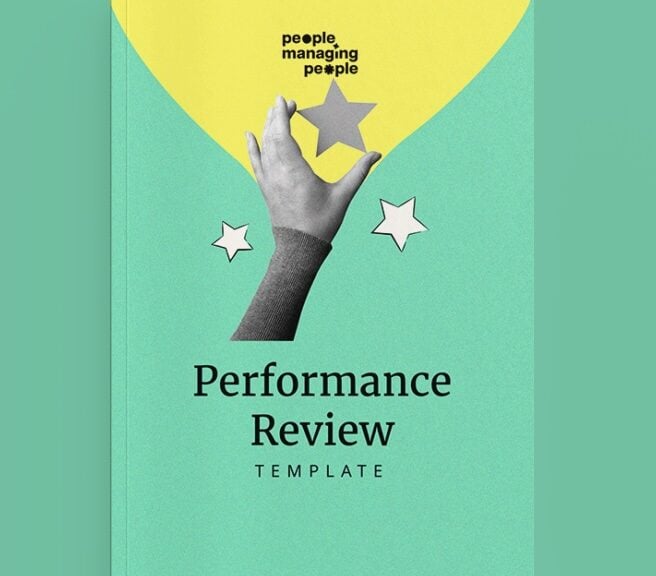While performance reviews might not be everyone’s favorite process, we cannot ignore the value to be gained from them when approached properly.
Performance reviews are opportunities for managers and direct reports to have a purposeful and focused conversation about someone’s performance, contributions to the organization, and opportunities to improve.
A properly conducted performance review can increase employee engagement and lead to an uptick in an employee's performance. But be aware the opposite impact can occur too!
Drawing from my personal experience conducting hundreds it not thousands of performance reviews, and helping organizations optimize theirs, I’ll share how to prepare for and how to conduct an effective performance review.
Quick Ask: Take our 60-second survey to share how you really feel about using AI agents in performance reviews, promotions, and coaching. Your input helps us better understand the real challenges HR teams face with AI in performance management.
How To Prepare For A Performance Review
Preparing to facilitate a performance review is not a task to take lightly, and it's certainly not something to do the night before the performance review is to be given!
Performance reviews take time to craft. If you rush it, your people will know.
Step 1: Reflect on your team and employee’s performance
The first step in preparing for a performance review is to reflect on the individual’s performance and also the performance of the team.
Consider what has happened that has been positive, neutral, or negative. What happened that was outside of the control of the team or individual? How does the individual contribute to the team? A reflection on these points is a great way to start.
Another thing to consider is your own perception. If you don’t work with the individual in their day-to-day, who does and who could give you information about how the team member has been performing recently?
Especially in cases where I manage highly independent employees, collecting feedback from peers can be exceptionally helpful in conducting fair, accurate, and valuable performance reviews.
Oftentimes, a 360-degree feedback process is used but this can be time-consuming. You can quickly collect feedback from colleagues about your team member’s performance using Google or Microsoft Forms.
When I reflect on an individual’s performance in preparing for a review, I often write the performance review prompts or questions designated by my company. I then use bullet points to identify a few things for each employee under the prompt.
In essence, I’m doing a shorthand version of the performance review which I will then expand in my narrative to include examples and recommendations for the future.
Step 2: Draft your feedback and link it to the expectations of the role
Once you’ve gathered your thoughts, any necessary peer feedback, and made your outline the review, you’re then ready to draft the narrative.
Writing the narrative is one of the most important parts of the review.
Arguably, this stage might be more important than the live conversation itself, especially in cases when you’re giving developmental feedback and you’re expecting an individual to change their behavior as an outcome of the meeting.
The narrative, in written form, is a document that people will go back to review their feedback, and it’s also an official document outlining performance and performance feedback for an individual employee.
Narratives of performance reviews (the written part) should always include performance statements, comparisons to the expectation or expected behaviors, detailed examples of good or poor performance, and how their performance impacts others.
KPIs and metrics are great measurement tools to be used in evaluating performance, identifying opportunities, and setting future goals for performance.
For example, if someone is in sales, you can outline their quality of work and accountability by noting how much they were able to meet the set goals and metrics. Just as goals should be measurable, so should performance.*
Narrative example
“Brent continues to struggle with detail orientation, especially when configuring our learning management system. The impact of Brent missing details, such as course enrollment, is that employees are not assigned to the courses they are required to complete. When people are not assigned to the right courses, such as compliance training, this means we as a company are out of compliance because we have not effectively facilitated the required compliance training.”
In addition to the narrative with concrete and measurable examples, you as the reviewer and leader should also be ready to describe how you’ll help the individual improve their skills or adopt the desired behavior.
Yes, performance review narratives can be long, but, in my experience, a longer, more thorough narrative is most helpful when working to help employees understand their performance and to document performance for the longer term.
*Useful article for goal setting: Putting Organizations On The Path To Success Using The Cascading Goals Method
Step 3: Prepare to deliver the performance review
Once you’ve collected your thoughts and any additional feedback, reflected on an individual’s performance, and written the narrative, you’re now ready to prepare to deliver the performance review.
If you’re preparing to have a hard conversation, game-plan how you will kick off the discussion and consider a few questions you think the team member will have at the outset. Be prepared to speak to each point with concrete examples.
Personally, I like to start on a positive note, highlight the good contributions the individual has made to the team in the review period, and then dive into the constructive criticism and opportunities for growth along with what I plan to do to support the employee along their journey.
Pro Tip: I often like to send my narrative to the team member just before joining the live conversation. I prefer the same from them as well, but not before I write my narrative.
This method of writing performance reviews is called a double-blind assessment. I find this method helps each person do their own work (none of this employee self-assessment regurgitation into manager review nonsense) and come to the conversation with reflective insights.
How To Conduct A Performance Review
You’ve done the prep, reflection, feedback collection, and writing the narrative. Now comes the part that matters most: the conversation.
This is where the performance review shifts from being just a formality to something useful. The live conversation gives you and your team member a chance to align, adjust, and reengage around the work and what’s ahead.
But don’t expect to stick to your script 100 percent.
The best conversations often come from the unexpected. When an employee brings up something surprising, maybe even something that feels off-base, that’s not a distraction. It’s insight.
When this happens, your job is to listen, stay curious, and keep the conversation productive and human. Here’s how to conduct the review in a way that makes it count.
1. Set the tight tone
Start by framing the conversation. You want to make it clear this isn’t a performance verdict, it’s a shared moment to reflect and plan. Creating that safety upfront can ease any tension and open the door for honest dialogue.
Example: “I appreciate you taking the time for this today. My goal is to walk through the feedback I’ve prepared, but just as importantly, I want to hear how you’ve experienced your work and where you see opportunities to grow.”
Setting that tone early creates psychological safety and lets your team member know the conversation is for and with them, not just about them.
2. Revisit goals and expectations
Before diving into feedback, level-set by reviewing the original goals and expectations for the review period.
Whip out the documentation of goals, targets or what the employee said they would do and perform a quick check-in on the objective completion of those items in the time allotted for them.
This helps re-anchor the conversation in what was agreed upon, and gives both of you a shared reference point for evaluating performance.
If priorities shifted mid-cycle, acknowledge it. If expectations were unclear, own that too. Grounding the conversation in context keeps it fair and focused.
3. Share your feedback clearly
Now it’s time to present your feedback in a way that’s direct, thoughtful, and grounded in specifics.
Start with what’s going well—call out the wins, strengths, and positive patterns you’ve seen, and then move into opportunities for growth.
Use concrete examples to illustrate your points, and be clear about the impact. Models like Situation–Behavior–Impact (SBI) can help structure your message.
As you talk through your observations, focus on behaviors and results, not assumptions or impressions. This helps the team member understand not just what you noticed, but why it matters.
Keep in mind that feedback lands differently for everyone. Some people will nod along; others may need time to process. Create space by pausing and asking for their perspective:
- “Does that match how you experienced it?”
- “Is there anything you’d add or see differently?”
If, as you’re sharing your feedback, they share something unexpected, or their version of events challenges what you assumed, stay open and let them talk it through without interruption.
You don’t need to resolve every detail in the moment. Acknowledge the input and let them know you’ll take it into account:
“Thanks for sharing that. I didn’t have that context, and I want to think about how it fits into the bigger picture.”
The goal here isn’t to “win” the conversation. It’s to build shared understanding.
4. Invite their perspective
Once you’ve shared your feedback, and potentially gotten a bit more information about how it went for your employee, shift fully into listening mode and invite the team member to reflect on their experience in the role.
This isn’t just a courtesy to the employee, listening to your employee’s perspective is part of understanding what’s working, what’s not, and what support they may need to keep growing.
Ask open-ended questions like:
- “What are you most proud of this quarter?”
- “What’s been your biggest challenge?”
- “What do you think helped you succeed (or held you back)?”
Let them speak without interruption. Even if their take doesn’t fully match yours, hearing their view helps build trust and surface any insights you may have missed.
When they do open up, validate the effort and vulnerability it takes to be candid and open and focus on development rather than being right or “correcting” their perspective.
5. Discuss development and career goals
Next, zoom out. Where do they want to grow? What’s exciting to them right now? Use this part of the conversation to shape future goals or stretch opportunities.
This shouldn’t be about fixing gaps or changing people. It’s about building on strengths, growing capability, and aligning development with where the business is going.
Be honest about what’s possible, but also be generous in where you offer support, coaching, visibility or connection.
Then, make it real. Whenever possible, connect their goals to actual business opportunities, such as stretch projects or emerging team needs, so the conversation feels relevant and grounded.
6. Set clear next steps
At the close of the review, summarize key points and agreements to ensure you both leave with shared clarity and an understanding of what happens next.
Translate broader feedback into concrete goals or development actions with timelines and clear measures of success, making sure they tie back to team or company priorities where possible.
If this means connecting your employee with someone else for mentorship, or adding them to an exciting new project, get that ball rolling immediately.
Also, be sure to establish a cadence for check-ins or informal follow-ups so the review becomes the start of an ongoing conversation, not a one-off event.
7. End on a positive note
Concluding the review with sincere appreciation reinforces the employee’s value and helps them leave the conversation feeling motivated and respected.
Close with something real and specific. Let them know what you value about their work, not as a formality, but as a reflection of their contribution. That could be a skill they’ve deepened, a project they owned, or the way they show up on the team.
Example: “I really appreciate how much steadiness you’ve brought this year. It’s helped the team stay focused during some hard pivots, and I see the impact of your work every week and I look forward to working with you on our upcoming projects.”
Ending with optimism about their future growth, and your commitment to supporting them, strengthens trust, boosts morale, and sets a forward-looking tone for the next phase of their development.
This helps your team member leave the review looking forward instead of looking back.
Finally, always leave the door open for follow-up. A great review conversation doesn’t end the feedback cycle. Instead, it sets the tone for how you’ll work together in the months ahead.
Performance Reviews Best Practices
Here are some performance review best practices to help you get the most out of this precious time.
Avoid one-sided conversations
When it comes to actually performing a performance review, it's easy to think that it's going to be a one-sided conversation with you as the manager telling your team member how they’re doing.
This is the exact behavior you need to avoid! A performance review conversation should be a two-way conversation.
When an employee talks about their performance, they learn and understand the reflective feedback much more than if you simply tell (or read) it to them.
Effective performance management can only be achieved if you facilitate a conversation to both share your reflective insights and obtain feedback from the employee or reviewee.
By giving constructive feedback, and having an open conversation, the review process will glean deeper insights on both sides, which will lead to greater performance over time.
Honesty is the best policy
One of the worst things that you can do in an employee performance review meeting is tip-toe around issues. This is true not just on performance review day but every day as feedback should be continuous, timely, specific, and actionable.
It's easy for barriers to exist between managers and an employee regarding communication and transparency. It's human nature and frequently requires a conscious effort to address.
One of the best ways to express your honesty during a performance evaluation is to think about what you know about the employee and how you think they’d like to receive feedback. It's a twist of the golden rule: treat others how they would like to be treated.
Some people may prefer you to be blunter, while others will need some easing in. We're all different when it comes to that.
If you're still struggling with honesty, one tip is to step back and look at your communication and other soft skills.
Regardless of what you do, always ensure that you end things on a positive, opportunity-focused note. You want them to leave the conversation feeling inspired and appreciated and with a clear roadmap of where they can improve.
Provide detailed feedback
When you're giving feedback, you don't want to be vague. You don't want to be sweeping broad strokes and just talking in analogies. You need concrete details and examples, especially when highlighting opportunities for improvement.
Perhaps there was something they did on a project last month that you want to bring up; maybe they got a project back on schedule or had a hand in things falling behind.
Be specific when explaining an example of performance, and be sure to highlight the impact of the good or not-so-good performance. By being specific and highlighting the impacts of behaviors, you help the person receiving the information understand how what they did impacts other people.
The more concrete examples you can give to back up your feedback, the better. I know examples can be hard to come up with if reviews aren’t so frequent.
This is why it's better to conduct performance reviews more frequently, such as monthly or quarterly, with a review period near the time the review is delivered. That way you can use examples whilst they’re fresh and the details are still clear.
Take your time and listen actively
When conducting the review, present your feedback and check for reactions: body language, tone of voice, and words.
When you give feedback, especially negative feedback, you might notice them go into flight mode and they’ll stop listening!
You also need to be empathetic to their viewpoint and on the lookout for interesting points they might raise during the review.
Don’t gloss over the opportunities to improve; take time to go over all of the feedback and discuss ways to address the feedback, including what you can do as a manager to contribute to an their growth.
Lead with empathy
Consider the environment and world of the individual you’re giving the feedback to. You never know what’s going on in someone’s life and, often, people don’t tell us about the most impactful, important things that are going on.
Practice empathy, don’t assume you know everything is going on, and give your people grace.
Make use of available tools
There are plenty of tools available to help while conducting performance reviews. Why not make use of them? They help make everyone's lives easier.
What tool you choose will depend on your organization, your working style, and how you go about conducting performance reviews.
One of my favorite features of performance review software is the opportunity to document follow-up along with the review itself so that you or a future manager can look back on the feedback and any notes of the conversation and the committed follow-up.
As a manager of people over a longer horizon, these are also great reflective tools to see how far your employees have come in their development.
Get used to giving feedback continuously, both good and bad
If you manage people, one of your primary duties is giving relevant, detailed feedback continuously—both good and bad. Giving regular feedback is an essential skill of management.
Focus the feedback on the behaviors, impacts, and outcomes of employees and consider your role and responsibility in developing your people.
Do not hold on to negative feedback over time, and do not wait for the next performance cycle to give feedback, especially negative feedback. Feedback, criticism, or developmental notes should never be a surprise in a performance review.
Brush up on giving effective feedback that is timely, specific, and outcome-focused.
Align your feedback with the expectations of the role
All roles and performance measurements require clear expectations to be effective.
Remember, a performance evaluation is intended to compare the individual’s performance in the role against the requirements of the role, not against their past performance or the performance of other teammates.
This is often confused and disaster occurs when performance is compared to anything that is not the clear expectations of the role.
If the role you’re evaluating does not have a job description with clear responsibilities, goals and KPIa, it’s time to get to work writing one so that future performance reviews can be based on an evaluation against clear, written expectations of the job.
Consider the context and structure of the performance review
If using scales or ratings, ensure alignment with the organizational expectations and norms.
Avoid being the manager who “never gives fives” in an organization where a top rating is given by other managers.
Often your HR team will have statistics on the portion of employees that typically receive each rating, use this information to your advantage in understanding how good performance is evaluated at your organization.
Pro Tip: If you’re evaluating the performance of individuals who consider themselves top performers, be careful not to discourage them by giving them a performance rating that could be considered to be “rounded down” or not comprehensive.
Often, the people performing at the highest levels are very aware of performance ratings and may be discouraged if their current performance rating is less than their previous rating, especially if they feel they have been working harder than normal in recent times.
Consider the impact of performance evaluations for high-performing individuals and how these people are motivated. Don’t let your cursory review of a strong employee’s performance cause a retention issue (yes, this is a very common problem).
Check your bias
Consider gathering feedback from multiple sources to mitigate bias in your reviews, especially if you don’t work super closely with your individual employees in your day-to-day.
For example, when I evaluate project managers, I know that my opinion of them as their manager is not actually what matters; instead, what matters are the opinions of those that the project managers serve.
To get this information, I send feedback requests to the key stakeholders of each project manager and gather feedback both about the performance of the individual project manager and the perception of the project management team.
Give your people an opportunity to reflect on your feedback
Get further clarity and ask questions. Often people need time to process information, and they may benefit from time to read your review, think about it, and then come to you with questions.
When conducting a performance review, leave the conversation somewhat open to invite further discussion and inquiry and to signal to your team member that you are there for them and committed to helping them grow personally and professionally.
Common Performance Review Examples
Let's now get into some review phrases you can make use of.
To begin with, you want to start with categories and prompts to cover during the performance review.
This is by no means a definitive list. Feel free to pick and choose and add in what you want, but, to get started, consider the following elements that can apply to almost every role in an organization:
- Strengths
- Opportunities for improvement
- Problem solving
- Communication
- Teamwork
- Accountability
- Quality of work
With each of these, you can then create specific performance notes highlighting positive or less-than-desirable examples of behavior exhibited during the review period.
Example positive performance review regarding communication
“Moriah’s communications are crisp, timely, and comprehensive. She excels at making sure the people that need to know…do know. For example, when Moriah led the launch of our new product update, all stakeholders, customers, support agents, and salespeople were informed and even had an opportunity to ask questions before the launch. Moriah navigates our fast-paced environment while balancing business outcomes with ensuring we are doing the right thing for our employees.”
Less positive review about communication example
“Sandra is a strong communicator but does not communicate key details of projects with stakeholders consistently, meaning some people are left in the dark on key matters. For example, in the website redesign project, Sandra and the team decided on when the new pages would launch, but Sandra did not lead the team in informing the leaders and rest of the staff about the upcoming website change, which when released, caught many people, including our CEO and key sales leaders, by surprise.”
Example of positive review regarding quality of work
“Moriah’s quality of work is exceptional. She sets the gold standard for planning, productivity, and organization to the point that others across the organization specifically request to work with Moriah because they trust the quality of her work and consistency in her delivery. Moriah is an influential player and helps to maintain high-quality standards across her team and the projects she is involved in. Moriah is contributing to developing others by training them on her practices and producing templates to help others learn similar quality skills.”
Example of less positive review regarding quality of work
“Sandra is capable of producing quality work, but only produces her best work when partnered directly with me, checking each incremental step along the way and making sure that Sandra is actively pursuing completion of the task. For example, Sandra committed to delivering a recommendation for changes to our learning system this quarter. When I approached Sandra to ask about the progress of this goal, she informed me that she had not yet started work on the task that was coming due in just a few weeks. Sandra got started, but needed a significant amount of direct interaction with me to make it through the task, including a few course corrections such as compliance requirements and reporting. Further emphasis and skill in time management, understanding the requirements of the task, and keeping stakeholders informed along the way will help to improve the quality of Sandra’s work.”
Remember, be specific. Using concrete examples to help justify your comments in each area will generate much better feedback rather than vague phrases like "they are a team player". The more you can justify it with prior examples, KPIs, and metrics, the better.
Performance Review Template

Get our Performance Review template!
Next Steps For Your Performance Reviews
As a manager, performance reviews are one of the most impactful activities you execute in your role.
If you’re a human resources leader, one of the core elements of your role is to help managers learn how to give effective performance feedback and facilitate performance reviews that motivate employees to perform their best.
Key takeaways
- As a manager, you should give both positive and negative feedback constantly, and all feedback should include specific examples and the impact of the behavior
- Formal performance evaluations should occur frequently, either quarterly or semi-annually if possible.
- Each role should have clear expectations for performance. Performance evaluations are to be done against the expectations of the role, not of an individual’s past performance or the performance of other team members.
- Ensure every employee has an opportunity to reflect on their performance as well.
- To prepare for the performance review conversation, document the highlights and opportunities of the individual’s performance in a narrative.
- Have a one-on-one conversation with the individual to go over both their assessment and your feedback on their performance. Throughout the conversation, share specific examples and concrete details of both positive and negative behaviors and their impact on the organization.
- After the performance review conversation, commit to any next steps and follow up via email or in your organization’s performance management tool.
- Remember, as a manager or evaluator of performance, you’re a key component of an individual employee’s growth and development. Be a partner, be honest, and be prepared to watch your employees soar to new heights!



